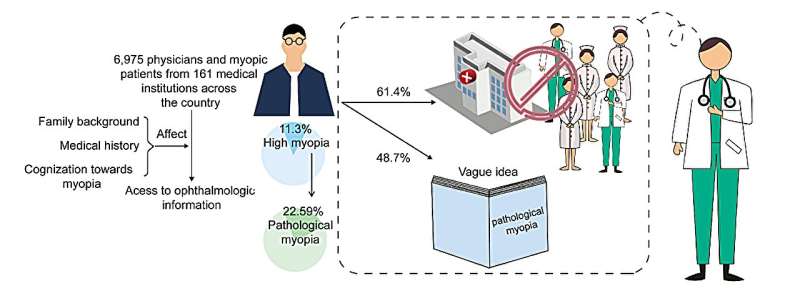This article has been reviewed according to Science X's editorial process and policies. Editors have highlighted the following attributes while ensuring the content's credibility:
fact-checked
proofread
Study from China reports a high prevalence of high myopia and pathological myopia but a lack of awareness

Myopia is the most common eye disease worldwide, with prevalence rates of 25-50% among adults in the United States and Europe and up to 85-90% among young people in Asian countries. In East Asia, myopia progresses at an amazingly rapid rate during childhood, and about 24% of patients may develop high myopia by adulthood.
High myopia can lead to a number of ocular complications and is an important risk factor for pathological myopia, which is usually characterized by a spherical refraction dioptre greater than -6.00 D, an axial length greater than 26mm, and a combination of pathological changes in the fundus. The prevalence of pathological myopia in young people with high myopia is about 8%, and the incidence of blindness and low vision is as high as 22.4% and 32.7%, respectively.
Myopia has, therefore, become a global public health concern.
Recently, a team of Xingtao Zhou and Jing Zhao from the Eye and ENT Hospital of Fudan University conducted a multicenter survey on "Awareness of high and pathological myopia among myopic patients in China: A cross-sectional multicenter survey" was published in MedComm—Future Medicine.
Six thousand nine hundred seventy-five doctors and myopic patients in 161 medical institutions were surveyed online and offline, and data on the proportion of patients with myopia, high myopia, and pathological myopia in China were collected.
The report also investigated the outpatient education status, doctors' expectations of patient education, patients' knowledge of high myopia and pathological myopia, and their access to related knowledge and analyzed the factors affecting patients' access to related information using multifactorial logistic regression.
The prevalence of high myopia was found to be 11.3% (22.59% with pathological myopia, and 22.45% experienced high myopia complications). 97.4% of patients with high myopia were engaged in work requiring frequent and prolonged eye use; 51.54% developed high myopia in adolescents between the ages of 11 and 20 years; 46.7% of individuals with high myopia exhibited a parental history of high myopia in one parent, while 19.6% manifested high myopia in both parents.
Patients' knowledge of high and pathological myopia was insufficient; nearly half of the doctors (48.7%) believed that patients had only a vague concept of high or pathological myopia and that there were some misunderstandings. Most outpatients (61.4%) did not have access to specialized myopia-related education for medical staff, and almost all doctors (98.4%) agreed that there was a need to increase patient education during consultations.
Most patients (64.5%) preferred to obtain ophthalmology-related information from general platforms (including search engines and Q&A platforms). Patients had different preferences and needs for ophthalmic information channels online, influenced by factors such as family background, medical history and knowledge of myopia.
In summary, the research team noted that despite the high prevalence of myopia or pathological myopia in China, patient awareness remains inadequate. Therefore, there is a need to improve patient education about high myopia and pathological myopia to reduce the incidence of adverse outcomes.
More information: Jing Zhao et al, Awareness of high and pathological myopia among myopic patients in China: A cross‐sectional multicenter survey, MedComm—Future Medicine (2023). DOI: 10.1002/mef2.64





















